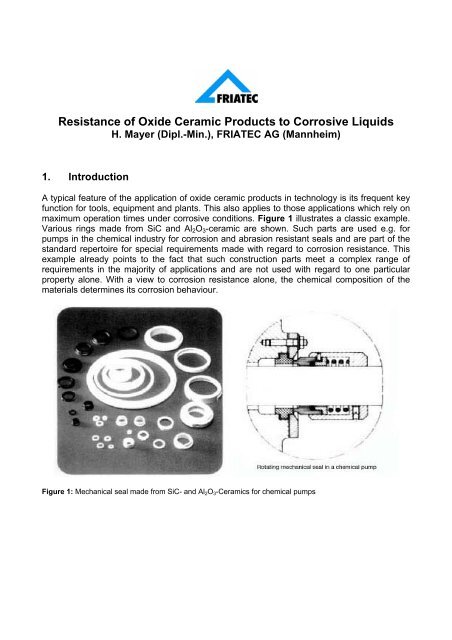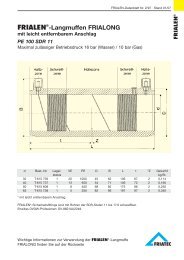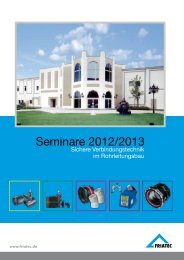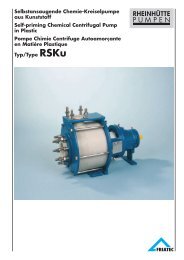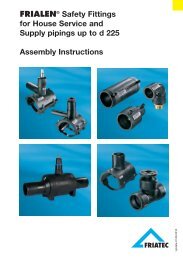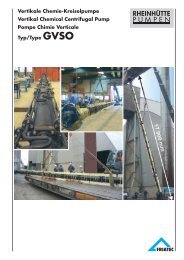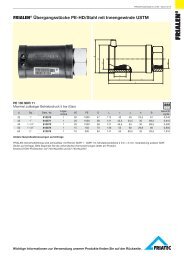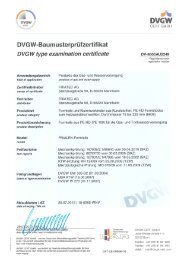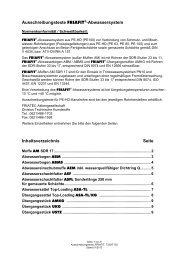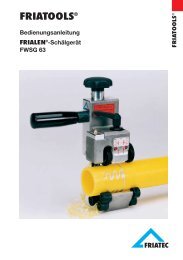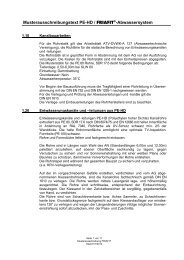Resistance of Oxide Ceramic Products to Corrosive Liquids - Friatec
Resistance of Oxide Ceramic Products to Corrosive Liquids - Friatec
Resistance of Oxide Ceramic Products to Corrosive Liquids - Friatec
You also want an ePaper? Increase the reach of your titles
YUMPU automatically turns print PDFs into web optimized ePapers that Google loves.
<strong>Resistance</strong> <strong>of</strong> <strong>Oxide</strong> <strong>Ceramic</strong> <strong>Products</strong> <strong>to</strong> <strong>Corrosive</strong> <strong>Liquids</strong><br />
H. Mayer (Dipl.-Min.), FRIATEC AG (Mannheim)<br />
1. Introduction<br />
A typical feature <strong>of</strong> the application <strong>of</strong> oxide ceramic products in technology is its frequent key<br />
function for <strong>to</strong>ols, equipment and plants. This also applies <strong>to</strong> those applications which rely on<br />
maximum operation times under corrosive conditions. Figure 1 illustrates a classic example.<br />
Various rings made from SiC and Al2O3-ceramic are shown. Such parts are used e.g. for<br />
pumps in the chemical industry for corrosion and abrasion resistant seals and are part <strong>of</strong> the<br />
standard reper<strong>to</strong>ire for special requirements made with regard <strong>to</strong> corrosion resistance. This<br />
example already points <strong>to</strong> the fact that such construction parts meet a complex range <strong>of</strong><br />
requirements in the majority <strong>of</strong> applications and are not used with regard <strong>to</strong> one particular<br />
property alone. With a view <strong>to</strong> corrosion resistance alone, the chemical composition <strong>of</strong> the<br />
materials determines its corrosion behaviour.<br />
Figure 1: Mechanical seal made from SiC- and Al2O3-<strong>Ceramic</strong>s for chemical pumps
2. Corrosion Types<br />
Corrosion processes occurring in oxide ceramic materials can be roughly subdivided in<strong>to</strong> four<br />
basic types with regards <strong>to</strong> their polycrystalline microstructure:<br />
Besides the more trivial aims <strong>of</strong> avoiding damage <strong>to</strong> the ceramic is not attacked or its<br />
complete dissolution after a short time either through an attack on the entire material or an<br />
attack only on the basic crystal in existing conditions, there is a need <strong>to</strong> emphasize the single<br />
attack on the substance at the grain boundaries <strong>of</strong> the ceramic material. That is where the<br />
material sits which does not dissolve in the basic crystal during the sintering process or which<br />
separates out from the basic crystal during cooling down from the sintering temperature. This<br />
inter-crystalline phase is naturally composed completely differently from the basic crystal itself<br />
and therefore has different chemical properties which either accelerate or slow down<br />
corrosion processes. Figure 2 illustrates this corrosion type in model form.<br />
Figure 2: Model <strong>of</strong> intercrystalline corrosion
If the substance <strong>of</strong> the grain boundaries may be corroded in existing conditions a corrosion<br />
front will develop along the crystal boundaries which may cause the complete destruction <strong>of</strong><br />
the material by dissolving the crystal boundary phase resulting in the crystallites falling out.<br />
While these inter-crystalline corrosion processes are not yet so advanced they are hardly<br />
noticeable macroscopically as the crystal boundaries are frequently markedly less wide than 1<br />
ųm.<br />
In practice e.g. lapped surfaces in that state show no changes neither in shining nor in the<br />
roughness compared <strong>to</strong> the state before the corrosion process started. In that state the<br />
strength <strong>of</strong> the material can be significantly reduced.<br />
3. Determining the Corrosion <strong>Resistance</strong><br />
In order <strong>to</strong> test the corrosion pattern <strong>of</strong> a material, special methods need <strong>to</strong> be used. Figure 3<br />
gives an overview <strong>of</strong> these.<br />
Figure 3: Methods for proving processes <strong>of</strong> corrosion<br />
To test corrosion resistance <strong>of</strong> Al2O3 ceramic FRIALIT-DEGUSSIT employs a type <strong>of</strong> test<br />
which provides a reliable result within a few days. This test involves a sample <strong>of</strong> the material<br />
<strong>to</strong> be immersed for three days in a boiling solution <strong>of</strong> 10% H2SO4 and then dyed in an<br />
alcoholic methylene blue solution. If the grain boundaries <strong>of</strong> the material are affected by the<br />
acid a blue tinting will become visible where an extraction <strong>of</strong> the grain boundaries has also<br />
taken place.
4. Effects <strong>of</strong> the Chemical Composition on Corrosion <strong>Resistance</strong><br />
The option <strong>of</strong> inter-crystalline corrosion leads us <strong>to</strong> believe that other materials <strong>of</strong> more than<br />
99% purity may present a completely different corrosion pattern in certain conditions<br />
depending on origin.<br />
In order <strong>to</strong> demonstrate this, a comparative corrosion test was carried out under above<br />
conditions on two different Al2O3 types. The two types <strong>of</strong> material were created from the same<br />
Al2O3 raw material with 99.8% purity and doping <strong>of</strong> 0.2% MgO, with the only difference being<br />
that one <strong>of</strong> the two types was doped additionally with 500 ppm SiO2.<br />
Figure 4 shows the result <strong>of</strong> this corrosion comparison which has been recorded at different<br />
time intervals. The fact that the material type B containing more SiO2 was affected after a very<br />
short time compared <strong>to</strong> type A is clearly visible.<br />
Figure 4: Corrosion comparison <strong>of</strong> two different Al2O3 substances with different SiO2 concentration
A polished section was produced from sample B which had corroded for four days and been<br />
thermally etched at 1450 ºC. Figure 5 shows the surface <strong>of</strong> this sample. You can see in the<br />
corroded zone that individual crystallites are missing in the structural composition;<br />
presumably these were expelled during the sample preparation as a result <strong>of</strong> corrosion<br />
processes.<br />
Figure 5: Al2O3 with raised SiO2 concentration after four days in seething sulfuric acid. Corroded border area,<br />
incident light.<br />
Figure 6: Al2O3 with raised SiO2 concentration after four days in seething sulfuric acid. Corrosion area, SEM.
Further enlargement in the scanning electron microscope (Figure 6) shows free crystal<br />
boundaries and deep gaps in places which also contain crystal boundary substance. Another<br />
noticeable feature is the hill-shaped deposits <strong>of</strong> material on the crystals (Figure 7). According<br />
<strong>to</strong> the results <strong>of</strong> an investigation using the electron beam microprobe the chemical<br />
composition <strong>of</strong> the grain boundary phase and the hill-shaped elevations is similar (Figure 8,<br />
9).<br />
Figure 7: Al2O3 with raised SiO2 concentration after four days in seething sulfuric acid. Corrosion area. Grain<br />
boundary and aggregation <strong>of</strong> material on grain surface. SEM.<br />
This result leads us <strong>to</strong> conclude that the deep gaps and the elevations arose only during the<br />
thermal etching process. The reason for this would appear <strong>to</strong> be a change in the viscosity <strong>of</strong><br />
the inter-crystalline phase due <strong>to</strong> certain components dissolving during the acid treatment.
Figure 8: EDX-spectrum <strong>of</strong> grain boundary phase (Figure 7)<br />
Figure 9: EDX-spectrum <strong>of</strong> the aggregation <strong>of</strong> material on one grain (Figure 7)
Further tests <strong>of</strong> the sample show that gaps also appear in the zone which has not been tinted<br />
(Figure 10), however, no material deposits can be seen on the crystal surface. This would<br />
suggest that corrosion processes have taken place in this part <strong>of</strong> the sample <strong>to</strong>o which have<br />
not yet caused sufficient extraction <strong>to</strong> prevent it from being tinted.<br />
Figure 10: Al2O3 with raised SiO2 concentration after four days in seething sulfuric acid. Mid <strong>of</strong> trial.<br />
Examining the microstructure allows differentiation <strong>of</strong> two corrosion zones, one which has not<br />
yet been extracted and an adjacent extracted zone which may be tinted due <strong>to</strong> deep damage.<br />
If the size <strong>of</strong> the crystallites <strong>of</strong> a material can be reduced <strong>to</strong> such a degree that a grain<br />
boundary phase which may be corroded does not affect the entire ceramic structure, such a<br />
material may be made more corrosion resistant.<br />
The simplest method <strong>to</strong> avoid such corrosion processes in principle consists <strong>of</strong> using only raw<br />
materials containing a low percentage <strong>of</strong> residual contamination as e.g. type A with a SiO2<br />
content <strong>of</strong> less than 100 ppm.<br />
The user <strong>of</strong> oxide ceramic materials may conclude from the above that an indication <strong>of</strong> purity<br />
on its own does not guarantee corrosion resistance as the composition <strong>of</strong> the grain boundary<br />
phase is a significant aspect.<br />
Comparative studies may help with an initial orientation when selecting corrosion resistant<br />
materials. Table 1 shows a section from such a table as an example. Here the corrosion<br />
behaviour <strong>of</strong> Al2O3 and ZrO2 ceramic on the application <strong>of</strong> different media is shown in<br />
comparison with other material groups.<br />
The real application conditions may lead <strong>to</strong> completely different results because <strong>of</strong> few<br />
changes in the composition <strong>of</strong> the chemical environment. Therefore, even <strong>to</strong>day, tests under<br />
service conditions in applications play a significant role in the selection <strong>of</strong> corrosion resistant<br />
materials.
Table 1: Part <strong>of</strong> a comparative corrosion table
5. Examples <strong>of</strong> Applications<br />
As mentioned at the beginning, products from oxide ceramic materials are used not only for<br />
one specific function in the majority <strong>of</strong> applications. Their strength is found in those areas<br />
where complex requirements need <strong>to</strong> be met.<br />
Typical examples from various industrial areas for tried and tested applications are:<br />
a) Dosage units from 99.7% Al2O3 ceramic for e.g. alkaline solutions, acids, medicines,<br />
pastes.<br />
b) Containment shells made from Mg-PSZ for magnetic coupling pumps <strong>to</strong> deliver acids<br />
and alkaline solutions in chemical plants<br />
c) Pressing dies made from Mg-PSZ achieve service times <strong>of</strong> more than 600 hours<br />
constant service when dry compacting highly abrasive and corrosive battery masses.<br />
d) The magnetically inductive flow meter shown in Figure 11 fulfils an extremely complex<br />
range <strong>of</strong> requirements. The central component <strong>of</strong> this unit consists <strong>of</strong> a pipe from ZTA<br />
ceramic with sintered platinum cermet. Such <strong>to</strong>ols allow measurement <strong>of</strong> e.g. the flow<br />
quantity <strong>of</strong> acids, alkaline solutions and abrasive deposits. Because they provide a<br />
high level <strong>of</strong> accuracy, these <strong>to</strong>ols are also used in bottling plants in the drinks industry.<br />
These products <strong>to</strong>day easily meet the requirements <strong>to</strong> be able <strong>to</strong> be steam sterilized<br />
and a high level <strong>of</strong> internal pressure loadability amounting <strong>to</strong> more than 1000 bar<br />
depending on manufactured size.<br />
Figure 11: magnetic inductive flowmeter
6. Literatur<br />
(1) Jaeger, G., Krasemann, R.: »Beitrag zur Kenntnis des Verhaltens der Sinter<strong>to</strong>nerde<br />
gegen Korrosion.« Werkst<strong>of</strong>fe und Korrosion 3 (1952), 401-415.<br />
(2) Dawihl, W., Klingler, E.: »Der Korrosionswiderstand von Aluminiumoxideinkristallen<br />
und von gesinterten Werkst<strong>of</strong>fen auf Aluminiumoxidgrundlage gegen anorganische<br />
Säuren.« Ber. DKG 44 (1967), 1-4.<br />
(3) Genthe, W., Hausner, H.: »Korrosionsverhalten von Aluminiumoxid in Säuren und<br />
Laugen.« cfi / Ber. DKG 67 (1990), 6-10.<br />
(4) Graas, T., Hollstein, Th., Pfeiffer, W., Reckziegel, A.: »Untersuchungen zum<br />
Korrosionsverhalten von Al2O3 + 10% ZrO2 in wässrigen Lösungen.« cfi / Ber. DKG<br />
74 (1997), 723 – 726.<br />
(5) FRIATEC AG, Division FRIALIT-DEGUSSIT: »Korrosionsbeständigkeit von<br />
Hochleistungs-Oxidkeramik.« Firmenprospekt Nr. 1512.5.1.90 L.


